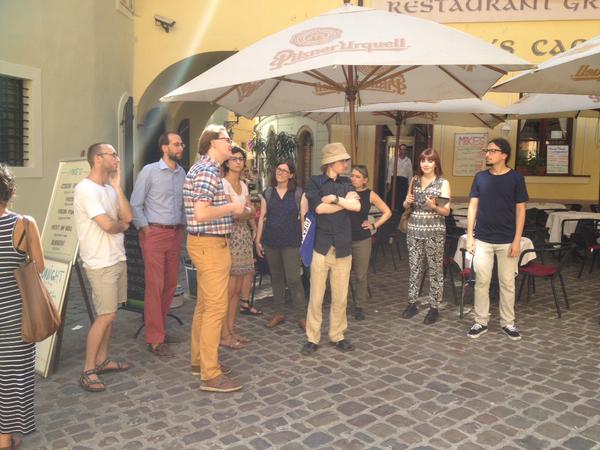The final day of the CENDARI summer school perpetuated the concept of interoperability that was introduced by Dr Toby Burrow’s paper the previous day. Emiliano Degl’Innocenti described the current situation of today’s medieval digital ecosystem as being fragmented or “full of walled gardens”.
Emiliano Degl'Innocenti on the Cendari Archival Research Guides to start day 5 @CendariProject #CendariSummer15 pic.twitter.com/SGpNkcux0M
— Cendari Project (@CendariProject) July 24, 2015
Emiliano’s description recalled the closed nature of traditional research methods; the current practice of storing information within closed files and databases. This emphasised the overall lack of interoperability in medieval studies and stressed the importance of developing a more open and share-focused mentality towards our own research. Resources such as the CENDARI Virtual Research Environment are perfectly positioned to realign our perceptions towards our research within a more open and networked framework, as it enables researchers to work within an environment that is specifically designed to be collaborative.
Starting collaborative work in the Cendari Archival Research Guides @CendariProject #CendariSummer15 pic.twitter.com/wdakjyYydz
— Cendari Project (@CendariProject) July 24, 2015
After brief student presentations on our own experiences with researching within the CENDARI Virtual Research Environment infrastructure, participants of the CENDARI summer school volunteered to share other digital tools and resources that they found benefiting their own research. I found this session of the day especially useful as it introduced further relevant resources that could be use to me in the future. The first resource to be presented was Regesta Imperii, a large international database of valuable articles and periodicals spanning from late antiquity to the early modern period and encompassing a number of disciplines including, archaeology, literary studies and history. This will undoubtedly be an invaluable resource for supplementing my bibliography.
I was also introduced to William Whitaker’s Words, a simple yet accurate online Latin to English and English to Latin online dictionary. I am expecting to undertake an undergraduate Latin module when term resumes in Autumn, a resource such as this will be of great assistance while familiarising myself with a new language. The fact that this resource has now been made available as an iPhone or smart phone application makes it more accessible and therefore more appealing to researchers such as myself.
Another useful database that was recommended was BREPOLiS, the online database for all material belonging to Brepols Publishers and their partners. Again, this will be another beneficial resource for augmenting my bibliography.
Interestingly, a researcher explained how we could use the styles in Microsoft Word to fully exploit the embedded XML tagging in the .docx file format. When you create a Word document, you are unconsciously writing in XML, hence the x in the .docx file format. The becomes obvious when you open a saved Word Document with Open Office, convert it to a zip file, extract the file and open it in XML Editor; the XML tags that are embedded in the Word document will show up. By using a Clean Up Style Sheet, you clear out the superfluous XML tags from Open Office and are left with the XML of the saved Word document. Since XML continues to reoccur as an important tool for the purposes of my research, and since I have not got a strong basis in coding, I and several other researchers interested in using XML found this revelation incredibly exciting.
Digitised Medieval Manuscripts app or DMMapp is another online resource that was put forward to the CENDARI summer school. This particular resource links researchers to more that three hundred library institutions that have digitised medieval material such as maps and manuscripts.
The final resource that was commended was DigiPal a digital resource which was developed by the Digital Humanities department in King’s College London to assist researchers in the study of palaeography and manuscript studies. As an Anglo-Saxonist with a strong research interest in Anglo-Saxon palaeography and manuscripts I was already aware of this valuable resource, but I was surprised to learn that one of DigiPal’s recent developments is the Virtual Machine which allows users to download the DigiPal framework onto their own machines to work with their own images from manuscripts that they are researching.
Ultimately I found the CENDARI summer school to be a thoroughly engaging and rewarding experience. Attending the CENDARI summer school benefited my research enormously as it introduced me to a range of innovative digital tools and technologies, but more significantly, it was instrumental in helping me make important international and national research connections within the digital humanities discipline.
![]() This work is licensed under a Creative Commons Attribution-NonCommercial-ShareAlike 4.0 International License.
This work is licensed under a Creative Commons Attribution-NonCommercial-ShareAlike 4.0 International License.

No Comments